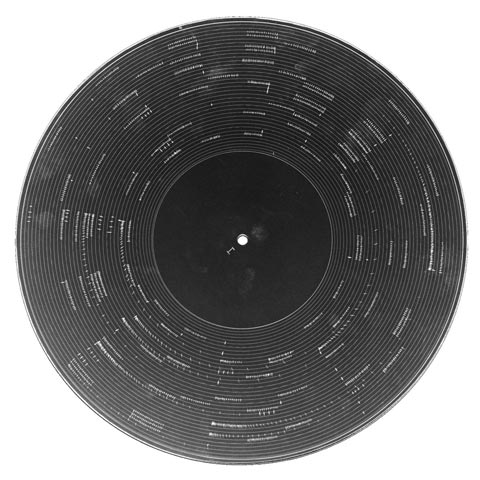|
MARTIN LORENZ - LIVE Martin Lorenz, Turntables November 16th 2012 | Message Salon, Perla-Mode, Zürich CH |
mp3 |
|
LOOP 06 Martin Lorenz DUMPF EDITION #01 | handcrafted vinyl | limited edition |
mp3 |
|
SIGNS - SHAPES Teodora Stepancic, Piano Martin Lorenz, Turntables DUMPF EDITION #03 | track 01 | mp3 |
COMPOSITION AS INSCRIPTION
Notes on the work of Martin Lorenz
In his article ‘Production – Reproduction’ *) published in 1922, the Bauhaus painter, designer and photographer László Moholy-Nagy argued in favour of a new utilization of the gramophone. It should no longer serve to reproduce sounds previously recorded, but should itself be used for the production of new, as yet inexistent sounds. Moholy-Nagy imaged that these ‘not yet extant sounds and sound relations’ would be scratched into the surface of the record directly by the composer. This early concept of sound synthesis came about within a field of tension that existed between notation and technology, in which the boundaries between composition and sound synthesis became blurred.
The work of the composer and percussionist Martin Lorenz shares with Moholy-Nagy’s concept the idea of a ‘scratched manuscript’, namely a direct, compositional inscription on the record. It too explores an intermediate realm spanning composition, sound synthesis and notation. However, the realms of ‘before’ and ‘after’ the scratching process are also fundamental to Lorenz’s work. The sounds that are scratched by hand on the record are placed there on the basis of algorhythmically generated intervals of time – for which the turntable speed of an LP (33 1/3 rpm) functions as the basic tempo. For some of his works, Lorenz first uses a computer to create sinus tone sequences by means of specific rules, then has these pressed on a record upon which he subsequently makes his manual interventions. The result is mixtures of sounds derived both from the scratches and from signals recorded previously. The ‘scratched’ sounds thereby receive a kind of ‘colouring’.
Already during the creation of his sinus tone sequences, Lorenz works on a micro-temporal level, using compositional means to structure the wave form of sinusoidal oscillations. Here, the boundaries are once more dissolved between sound synthesis and composition, as also between notation and sound production – this time in the digital realm. The records produced thus become a hoard of sonic structures from which Lorenz, as turntablist, creates new musical relationships during his live performances.
The direct compositional synthesis of the sounds brings Lorenz’s work close to the so-called ‘non-standard synthesis’ as developed by the composers G. M. Koenig, Herbert Brün and Iannis Xenakis. In their work, the digital sample attains greater musical dimensions and is organized with the aid of compositional rules. These sound synthesis methods derive from applying algorhythmic compositional principles (thus a regular, formalized description of the compositional process) to the production of sound. As in the ‘non-standard synthesis’, Lorenz’s work also takes the limitations and prerequisites of the medium as its starting point and combines compositional, regulated procedures with the production of sound itself. Whereas these methods lead to extremely complex results in the work of composers such as Koenig, Brün and Xenakis, Lorenz is by contrast interested in minimal, combinatorial processes. Above and beyond this, medial overlayerings and reciprocities take place in Martin Lorenz’s work. The compositional process begins with a regular description of a sound-wave form in the digital realm, and then proceeds to move into the mechanical, analogue realm. The digital functions in Lorenz’s work as something virtual that is then concretized in the analogue realm in physical, mechanical and performative terms.
Herbert Brün wrote: ‘Music is the traces that composition leaves behind’ **). The creation of traces in digital wave forms and mechanically on the record are the focal points of Martin Lorenz’s work; the compositional process becomes an act of inscription.
Luc Döbereiner, August/September 2011
*) László Moholy-Nagy: “Produktion - Reproduktion”, in: De Stijl, Jg. 5, H. 7 (Juli 1922), S. 98-100.
**) Herbert Brün: “As to the Computer...”, in: Arun Chandra (Hrsg.): 2004. When Music Resists Meaning, Middletown: Wesleyan UP, S. 216-224.

Martin Lorenz, LOOP 06, handcrafted vinyl, LE 20/20

Martin Lorenz, FREQUENCIES, handcrafted vinyl, LE 20/20
